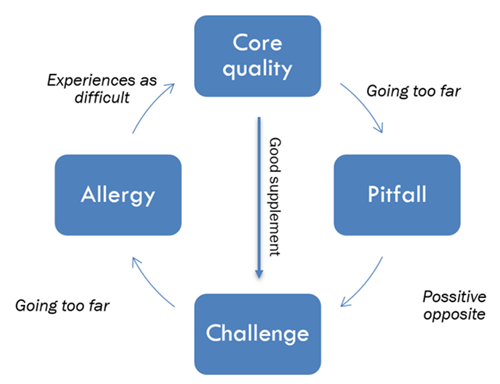OPTO as a coaching tool
There is no doubt, that OPTO has been developed by Master International with a focus on recruitment. Luckily this does not limit the use of OPTO to only recruitment. In this article, the unfolding of the OPTO profile will show the reader one way to work with the profile in a coaching setting. The use of this approach is relevant in coaching with a focus on exploring the coachee’s awareness and experience with own behaviours and the development of alternative behaviours. And where there is a general transformative approach to the coaching setting, such as described by Reinhard Stelter (2015) and his ideas of Third Generation Coaching.
The conceptual framework
This conceptual framework is based on the ideas of Daniel Ofman (2004), using a simplification of his model Core Quadrant®. The basic idea of this model is a framework consisting of 4 quadrants, that can assist in the personal development, by helping to understand the way a person engages with others, and what personal qualities are applied.
Ofman (2004) shows how a core quality or a personal strength can go too far and transgress into a pitfall, and in which way this core quality can take on the challenge to adjust the behaviour. Additionally, by understanding your own core qualities, you can understand why some people “rub you the wrong way”, or as Ofman (2004) calls it; why you develop an allergy to some people.


Figure 1: Adapted model of Ofman’s Core Quadrant®
A core quality is the strength in a person. It is the qualities and abilities you have, when engaging in different situations and activities. These are often natural qualities, that both you and others see as positive sides and define how you see yourself. An example could be, that you see yourself as punctual.
A pitfall is when the core quality becomes a weakness. This happens when the quality becomes too much and exaggerated. This is a negative side of yourself and has a negative effect on the environment surrounding the person. An example could be, when the punctuality becomes pushy and perfectionistic.
A challenge is the positive opposite of the pitfall, that can strengthen and complement your core quality. You can work with your challenges, and they can help you to have alternative strategies of behaviour. This can create more balance and more nuances in your behaviour. An example could be to learn to postpone and leave things as they are.
An allergy is the direct opposite of your core quality. Just like the pitfall is exposed when the core quality is exaggerated, your allergy is activated, when your challenge is being exemplified too far. In this case the core quality deteriorates into the allergy. The allergy can also be exposed when you are confronted with your own challenge in others. An example could be, when the postponement takes form as laziness and being disorganised.
OPTO profile
In OPTO we are inspired by the concept of the core quality and call it Profile Strength. In this context it is imperative to highlight, that OPTO measures what people are (core qualities) and not what they are not (pitfalls). We do not address pitfalls in OPTO, as we do not assess them, and it is not the objective with the Big 5 model (McCrae, R. R. & Costa, P. T. Jr., 1999).
When using the OPTO profile in coaching we look at the strengths of a profile. It becomes equally interesting to understand and learn, how a person is attentive and experienced with alternative actions in situations, where the natural behaviour, does not help the person to excel in what they do. The questions in the interview guide are designed to unfold the understanding of what alternatives the person recognizes in him or herself.
In a coaching session the coach can help the coachee to unfold the challenges by using the Core Quadrant® framework. Remembering that the challenge can be a good supplement to the Profile Strength, and the objective with this approach in coaching is to strive for a balance between the two, so they become complementary person specific qualities.
Unfolding the OPTO profile
By unfolding situations, that may cause challenges, it can create a great supplement to the Profile Strength and be an option to excel as a person and as a high performer. The coaching session is an opportunity for the coachee to become aware of the strengths and related challenges, and to develop tools for balancing both typical and alternative behaviours.
As a first step the coach can dive into the report together with the coachee and look at the Top Drivers of Performance, as stated in the report. The Top Drivers of Performance are perceived as the most visible strengths of the profile, and they will impact the whole profile. This is what comes naturally to the person, and what the person finds most effortless. The Top Drivers of Performance are typically very visible to both the person self, and to others around.
The OPTO report includes keywords describing the Top Drivers of Performance, which are key words based on the highest-ranking Dimensions of the profile. You could say that these Dimensions are what “colours” the profile. For more detailed specifications of the profile it is also advised to give importance to the Aspect level in the report.
The next step is to investigate the challenges, as situations and contexts requiring an alternative behaviour from the coachee. The coach can ask directly of examples of when the Top Drivers have been inadequate to address a specific situation, or when they have been perceived as negative.
Ultimately the coach can use the interview guide to get inspiration on how to unfold the Dimensions and Aspects by looking at strengths and challenges through the presented questions. The intention with the questions is for the coach to get the best out of using the Interview Guide, which by design is meant to explore the candidate’s awareness and experience with alternative behaviours. Parallel to that, being curious about the coachee’s repertoire of alternative behaviours.
An example
In the example given here the respondent’s Top Drivers are Compliance and Delivery.


Figure 2: Example from an OPTO report by Master International
Let us look into the first of the Dimensions; Compliance. Compliance measures whether one is dutiful, sincere, and will show conscientiousness at work. E.g. the degree of Dutifulness and the degree of Sincerity will determine how Compliance is expressed in work and is experienced by others. The keywords for this Dimension are Conscientious, Sincere and Authentic. This means that with minimal effort the person is very compliant and upholds commitments.
A possible challenge for this person could be to use flattery to get ahead, and it will require an effort to neglect, what the person perceives as duties.
The coach can then use the Interview Guide questions in the report as inspiration to unfold the profile together with the coachee:
- When is it important to say no to additional commitments?
- When is it justifiable to use any means necessary to get ahead?
These questions can inspire the coach to further questions regarding the challenges and is a way of letting the coachee express and unfold the alternative behaviours in his or her own pace, using their own words. Being a step towards developing these alternative strategies of behaviour.
For further exploration, the different Top Drivers of Performance and the challenges linked to them, can be combined giving a more complex picture of the coachee, and even more diversity in the expressed behaviour.
Awareness creates unity
The final objective with this focus in coaching can be to create unity. By making the coachee aware of strengths and challenges, the coachee can dose the adequate behaviour to a given situation, to create a balance, to use both strengths and challenges, and to be more strategic in how he or she interacts with others. This can be trained by unfolding the OPTO profile through coaching.
OPTO is our Personality Test. If you are interested in reading and learning more about Personality tests and how they can be used in different settings, please click here.
References
McCrae, R. R., & Costa, P. T., Jr., 1999. A Five-Factor theory of personality. In L. A. Pervin & O. P. John (Eds.), Handbook of personality: Theory and research (2nd ed., pp. 139-153). Guilford.
Ofman, D., 2004. Core Qualities: A Gateway to Human Resources. Cyan Communications.
Stelter, R., 2015. A Guide To Third Generation Coaching. Springer.





